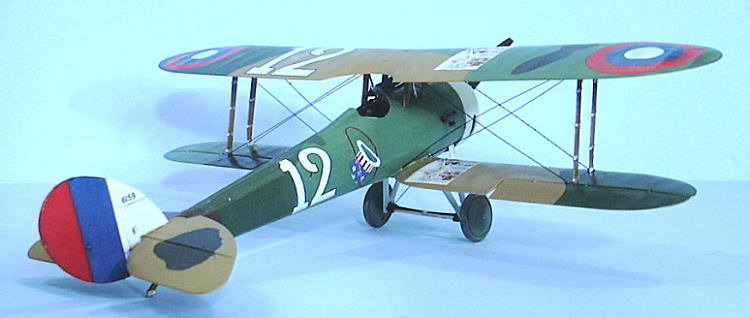
Roden 1/32 Nieuport 28
| KIT #: | ? |
| PRICE: | $59.95 MSRP |
| DECALS: | Two Options |
| REVIEWER: | Tom Cleaver |
| NOTES: |

| HISTORY |
The Nieuport line had been
established with the Nieuport 10 as a light-weight, rotary-powered airplane with
a sesquiplane layout in which the lower wing is less than half the area of the
upper wing.
The design was solidified with the Nieuport 11 "Bebe," which
appeared in late 1915 and did much to erase the "Fokker Scourge" in early 1916.
The Nieuport design became "classic" with the Nieuport
17, the mount of such aces as Guynemer, Nungesser, Ball and Bishop in 1916-17.
However, by 1917 it was obvious the design had seen
better days, with the Nieuports 23, 24 and 27 being essentially variations on
the theme of the Nieuport 17.
The heavier and faster SPAD VII and the later XIII paved
the way for the fighters of the last year of the Great War.
Nieuport answered the SPAD VII with
the Nieuport 28, which maintained the tradition of light weight and rotary
power, but changed to a biplane design with upper and lower wings of equal area
and a hefty increase in speed.
Aesthetically, the Nieuport 28 was among the
best-looking fighters of the war, with its gracefully rounded wingtips and
curvaceous tail, mated to a slim cigar-shaped fuselage.
Unfortunately, the design was not as robust as the SPAD
series.
France had to concentrate its limited aeronautical and industrial
resources, and the French Air Force chose the SPAD, rejecting the Nieuport in
late 1917.
This left Nieuport with the choice
of becoming a sub-contractor for SPADs, or trying for a new design (which they
did with an unsuccessful design known as the Nightjar). The Imperial Russian Air
Service had earlier ordered 200 Nieuport 28s, though deliveries had been delayed
and then stopped by the events of 1917 th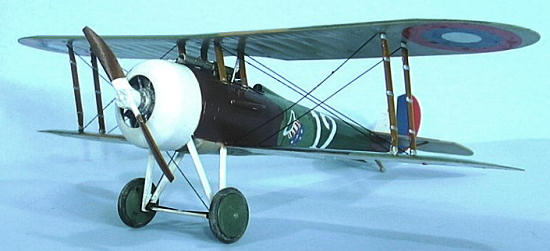 at led to the October Revolution,
leaving the Nieuports finished in their crates.
Fortunately, there was another customer - the United
States - anxious to find a single-seat fighter for its new air force, and
experiencing difficulty in obtaining the main fighters of its British and French
allies.
The United States had entered the war in April 1917 with essentially no
air force, and no domestic designs capable of competing successfully with
European designs.
Nieuport had the ability to deliver the Nieuport 28
quickly; in fact, it was this availability of these fighters that was the reason
why the United States adopted what had previously been the Imperial Russian
cockade as the US insignia for aircraft during the war.
The deal was struck in early 1918, and the Nieuport 28
became the first single-seat fighter of the U.S. Army Air Service.
at led to the October Revolution,
leaving the Nieuports finished in their crates.
Fortunately, there was another customer - the United
States - anxious to find a single-seat fighter for its new air force, and
experiencing difficulty in obtaining the main fighters of its British and French
allies.
The United States had entered the war in April 1917 with essentially no
air force, and no domestic designs capable of competing successfully with
European designs.
Nieuport had the ability to deliver the Nieuport 28
quickly; in fact, it was this availability of these fighters that was the reason
why the United States adopted what had previously been the Imperial Russian
cockade as the US insignia for aircraft during the war.
The deal was struck in early 1918, and the Nieuport 28
became the first single-seat fighter of the U.S. Army Air Service.
Force Majeure stepped in to
decide that the little Nieuport would become the first fighting scout of the new
United States Army Air Service. By March, 1918, as American flying personnel
finished their training in the United States and France, 297 Nieuport 28s were
transferred to the U.S.A.S. and became the initial equipment of the 94th
and 95th Aero Squadrons, as well as
the 103rd Aero Squadron, formerly the Lafayette Escadrille, which formed the
First Pursuit Group of the U.S. Army air Service. It would also be original
equipment for squadrons of the Second Pursuit Group, though they would not take
it into combat, having equipped with the SPAD XIII by the time they went to the
front in July 1918.
The squadrons of the First Pursuit
Group, received their airplanes beginning in late April 1918.
Initially, the airplanes were delivered without
armament, due to shortages of Vickers machine guns, and in fact most of the
airplanes flown by the three American units only carried one machine gun until
shortly before they were re-equipped with the SPAD XIII in the late summer of
1918, though most pilots continued to use only one gun due to the deleterious
effect on performance of the weight of the second weapon.
As they began to fly their new mounts, the Americans
were forced to discover for themselves the things that had led to the French
rejection of the airplane, such as its propensity for shedding the fabric of the
upper wing in a prolonged dive.
After several unexplained fatal crashes, Eddie
Rickenbacker experienced this on May 11, 1918, and was able through superior
flying ability and luck to bring the badly-damaged airplane back to Toul
airdrome, where subsequent investigation was able to finally f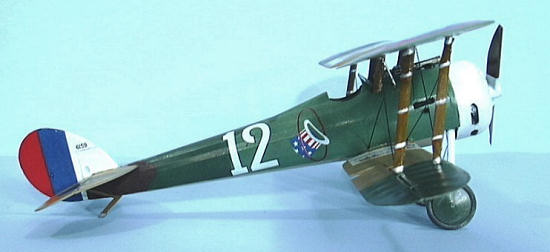 ind the cause of
what to then had been mysterious and unexplained crashes, this being
insufficient attachment of the upper wing fabric on the upper surface (it was
tacked to the ribs), which allowed the fabric to “balloon” from the internal air
pressure differential, leading to bursting or ripping of the fabric and loss of
the aerodynamic surface. The First Pursuit Group never liked the Nieuport,
though other U.S. units who learned to fly the airplane within its limits did
like it and several were actually reluctant to trade it in for the
(comparatively) heavy SPAD XIII; it must be remembered, however, that the
experience of the First Pursuit Group involved green pilots flying combat
against a highly-experienced foe.
ind the cause of
what to then had been mysterious and unexplained crashes, this being
insufficient attachment of the upper wing fabric on the upper surface (it was
tacked to the ribs), which allowed the fabric to “balloon” from the internal air
pressure differential, leading to bursting or ripping of the fabric and loss of
the aerodynamic surface. The First Pursuit Group never liked the Nieuport,
though other U.S. units who learned to fly the airplane within its limits did
like it and several were actually reluctant to trade it in for the
(comparatively) heavy SPAD XIII; it must be remembered, however, that the
experience of the First Pursuit Group involved green pilots flying combat
against a highly-experienced foe.
The 94th
“Hat in the Ring” squadron (the insignia represented Uncle Sam’s hat “thrown
into the ring” of combat) was initially commanded by Lafayette Flying Corps ace
Major Raoul Lufbery, who managed to transmit what he had learned in two years of
combat over the Western Front to such untried Americans as Douglas Campbell,
Alan Winslow and Eddie Rickenbacker before he was killed in combat in June 1918,
falling to his death to escape his burning fighter.
Rickenbacker, Campbell and Winslow
accompanied Lufbery on the first combat air patrol over enemy lines on March 19th,
1918. Several more patrols were flown by other members of the unit during the
course of the rest of that month and early April, without seeing major combat.
On April 14th, Campbell and Winslow
shot down two German observation airplanes, these being the first victories by
Americans flying in the American Air Service of the First World War.
Eddie Rickenbacker: America’s “Ace of Aces”:
Born October 8, 1890, Eddie
Rickenbacher was famous in America before the war as a race car driver for the
Duesenberg Corporation, and was the first to drive faster than “a mile a
minute,” which led to his becoming the first to have the nickname “Fast Eddie”
(from which all others descend).
On the outbreak of war, with the official policy of
promoting anti-German feeling, he changed the spelling of his name to
“Rickenbacker” to “take the Hun out of it.” He joined the Army when war was
declared, and came to France on June 26, 1917, with the rank of Sergeant First
Class in one of the first American units to go to war. He was soon taken on as
chauffeur for General John J. “Black Jack” Pershing, commander of the American
Expeditionary Forces. Though he was considered “too old” (at 27) to fly, and
lacked the necessary educational background demanded by the U.S. Air Service for
a commission, he
managed to convince the General to approve his transfer to the
Air Service. He took flight training under the French at Issoudun, as had
Campbell, Winslow, and the other original members of the 94th,
all of whom had enlisted shortly after the U.S. entry into the war and been sent
to France for training since the U.S.A.S. was still setting up its flight
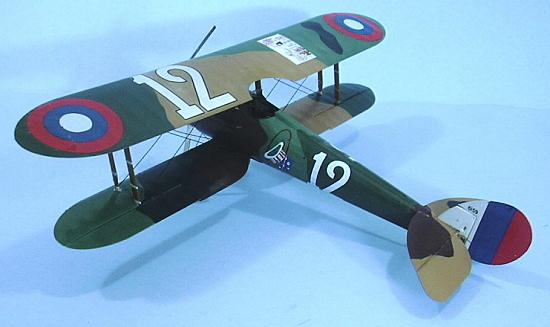 schools. Rickenbacker’s well-known mechanical skills led to his being assigned
as engineering officer at Issoudun, and he had to fight to obtain an assignment
to the 94th Aero Squadron.
schools. Rickenbacker’s well-known mechanical skills led to his being assigned
as engineering officer at Issoudun, and he had to fight to obtain an assignment
to the 94th Aero Squadron.
Rickenbacker scored his first
victory on April 29th when he shot
down an Albatros D.V, and his fifth on May 30th,
to be recognized as America’s second ace. He very nearly did not survive to make
that fifth kill; in combat a week previous, he put his airplane in a dive to
escape the enemy, and the fabric on the upper surface of the right wing came
loose as described above. The fact that Rickenbacker was the only pilot to
survive such an event, managing to bring the airplane in to a “hot” landing at
Tours field despite losing half of the upper wing, was a demonstration of flying
skill that singled him out as being head and shoulders above the others in
regard to ability, despite being “too old.”
Shortly after his fifth victory, an
ear infection sent him to the hospital for several months, and he did not return
to operations until the latter part of September 1918, just in time to
participate in the Meuse-Argonne Offensive, America’s major contribution to
victory over Germany. In six weeks of almost-daily combat, Rickenbacker scored
an additional 21 official victories (he may have scored twice that number,
though they happened behind enemy lines and could not be confirmed) while rising
to lead the 94th Aero Squadron.
Such performance clearly demonstrated he was worthy to be considered alongside
Mannock and McCudden, Guynemer and Nungesser, or Richtofen and Udet as one of
the truly great combat pilots of the First World War.
His autobiography - “Fighting the Flying Circus” - is
one of the best accounts of air combat in the First World War I ever read. The
book is now in the public domain and available online at
http://www.richthofen.com/rickenbacker/ - I recommend it highly.
Rickenbacker’s actual totals were
23 whole kills, two “half kills” shared with another aviator, and one shared
with two other pilots, or 24.33 by modern measurements. While the US Air Service
credited "out of control" and other non-fatal victories, in terms of aircraft
destroyed, Rickenbacker's tally was six airplanes and three balloons in the air,
plus two balloons on the ground. Several other Americans have more enemy
aircraft destroyed but fewer credited victories, including Frank Luke.
Raoul Lufbery flew with the French and has no official
U.S. Air Service credits. Rickenbacker’s total of 300 combat hours is reportedly
more than any other American pilot in the war.
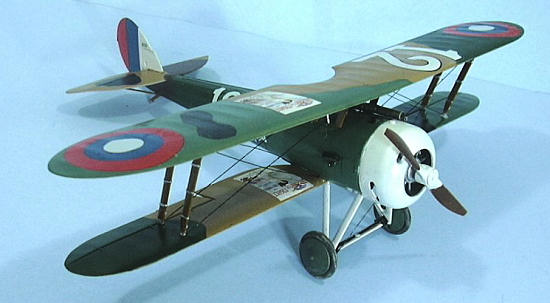 After the war, Rickenbacker started
a car company which introduced the first vehicle with four-wheel brakes, which
is now the world standard, but which was resisted by the automobile industry at
the time with such vehemence that the company went bankrupt.
He bought the Indianapolis Motor Speedway in 1927 and
was responsible for all the modernization, such as banking curves, at the
course.
After the war, Rickenbacker started
a car company which introduced the first vehicle with four-wheel brakes, which
is now the world standard, but which was resisted by the automobile industry at
the time with such vehemence that the company went bankrupt.
He bought the Indianapolis Motor Speedway in 1927 and
was responsible for all the modernization, such as banking curves, at the
course.
In 1932, Rickenbacker combined
Eastern Air Transport with Florida Air Lines to create Eastern Air Lines,
becoming one of the leaders responsible for the introduction of nearly every
modern technological development in air transport from the DC-3 to the DC-8.
During the Second World War, he was
a consultant to the Army Air Forces, In October 1942, he was aboard a B-17 bound
to Canton Island from Pearl Harbor that went down due to a navigation error.
Everyone was injured to varying degrees in the crash, and food ran our after
three days.
For 24 days Rickenbacker, his business associate Hans Adamson and
the surviving crew drifted in a rubber raft.
On day 8, a seagull landed on his head, and he captured
it.
They ate it and used the remains for fishing bait. After two weeks of
unsuccessful search, the USAAF was ready to call of further effort, but
Rickenbacker's wife, Adelaide, convinced Hap Arnold to extend the search another
week. For the second time in his life (the first being a crash in 1941) the
press reported that Rickenbacker was dead.
On November 13, 1942,
Navy pilots rescued the survivors - all suffering from
exposure, dehydration, and starvation - off the coast of Nukufetau near Samoa.
One crew member had died and been buried at sea.
All credited Rickenbacker - who wrote a book about the
incident in 1943, “Seven Came Through” - for their survival.
In 1963, Eddie Rickenbacker retired as Chairman of Eastern Airlines. He died from the complications of a stroke in 1973. The Rickenbacker Causeway connecting Key Biscayne to the mainland is named in his honor. He was the cousin of Adolph Rickenbacker, co-founder of Rickenbacker Guitars.
| THE KIT |
There have been several Nieuport 28
kits released over the past 50 years in 1/48 and 1/32 scale, beginning with the
release of the Aurora Nieuport 28 in the fall of 1957.
Until 1997, this was the only 1/48 Nieuport 28, though
Revell released one in 1/72 in the
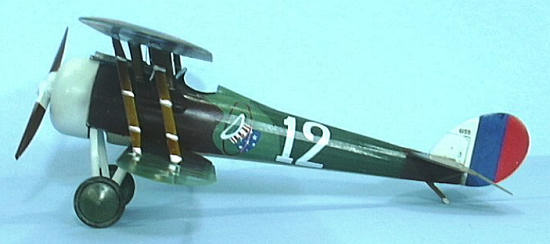 mid-1960s.
Blue Max released a limited-run 1/48 Nieuport 28 in
1997, which is still the best kit in that scale for overall shape and surface
detail accuracy.
Roden released a Nieuport 28 in 1/48 in 2005.
mid-1960s.
Blue Max released a limited-run 1/48 Nieuport 28 in
1997, which is still the best kit in that scale for overall shape and surface
detail accuracy.
Roden released a Nieuport 28 in 1/48 in 2005.
This 1/32 kit is the first Nieuport
28 in this scale, and it is also easily the best Nieuport 28 in any scale.
Crisply molded in medium-grey plastic, all flying
surfaces are thin with sharp trailing edges, and highly accurate fabric detail -
no “hills and valleys,” and the underside of the wing done right.
The fuselage fabric area is also right: faceted with
only very slight concave curves between the stringers.
Essentially the kit is the 1/48 kit scaled up, which is not a bad thing. Detail is sufficient that a modeler can do the project OOB, while a super detailer has the essential basics to start a project. The kit is simple to construct and the rigging is basic enough that this would be a good kit for a first-time biplane modeler.
| CONSTRUCTION |
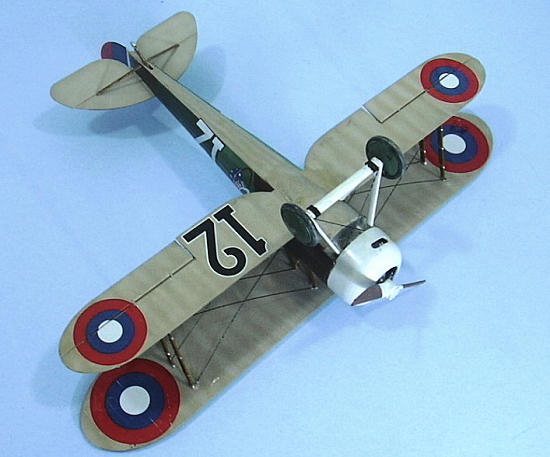 Construction is the essence of
simplicity, to the point where if you are considering your first World War I
biplane project and have been put off by their alleged difficulty, then this is
the kit for you.
Construction is the essence of
simplicity, to the point where if you are considering your first World War I
biplane project and have been put off by their alleged difficulty, then this is
the kit for you.
Some of the more “serious” WW1
modelers I know say that the kit-supplied cockpit needs more detail. I guess I
must not be very serious, since I operate on the theory that “if you can’t see
it, I don’t care about it.” The cockpit opening is small enough that all you’re
going to see is the seat and a bit of the side frame detail. Thus, to me, using
the kit-supplied cockpit without worrying about super-detailing resulted in a
good-looking model.
The kit instructions are easy to
follow, and doing so will result in a model that is assembled to the point of
being ready to paint in an evening. By that, I mean the fuselage, lower wings
and tail surfaces are assembled together. Depending on which airplane you’re
going to do, you may or may not wish to attach the engine and the cowling at
this point; since I was doing the Rickenbacker airplane with a simple white
cowling, I attached the nicely-detailed engine and cowling at this point, to
assure a good fit.
| COLORS & MARKINGS |
Painting:
I used Tamiya “Buff” for the clear
doped linen lower surfaces, with the upper camouflage done with Tamiya “Desert
Tan,” “Dark Green,” “Flat Brown,” and
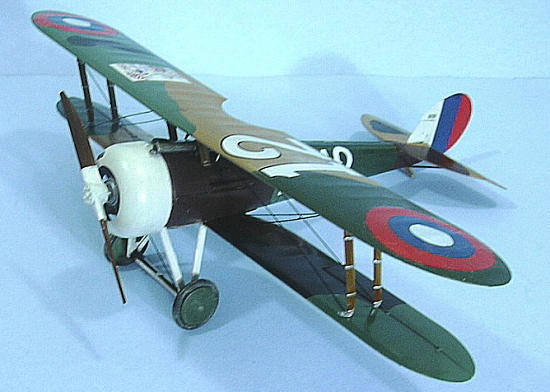 Gunze-Sangyo “Light Green.”
I used Xtracrylix “White” for the cowling, prop, and
rudder.
The camouflage pattern was masked for a hard edge.
I finished off with a coat of Xtracrylix “Gloss”
varnish.
Gunze-Sangyo “Light Green.”
I used Xtracrylix “White” for the cowling, prop, and
rudder.
The camouflage pattern was masked for a hard edge.
I finished off with a coat of Xtracrylix “Gloss”
varnish.
Decals:
The kit decals went on without problems under a coat of Micro-Sol. I then gave the model a second coat of Xtracrylix “Gloss” varnish.
| FINAL CONSTRUCTION |
I used the Tamiya weathering set to
apply “mud” to the wheels.
The simple rigging was done with .010 wire painted
black.
| CONCLUSIONS |
The Nieuport 28 is definitely one
of the most beautiful World War I airplanes in terms of its design aesthetics.
Having built models of this airplane in 1/72 and 1/48, I am even more convinced
that 1/32 is the best scale for World War I fighters.
Overall, this is an easy model for someone who hasn’t
done a World War I biplane before.
It is easy to assemble and the rigging is relatively
simple.
Highly recommended.
Review copy courtesy Roden.
October 2008
Copyright ModelingMadness.com
If you would like your product reviewed fairly and fairly quickly, please contact the editor or see other details in the Note to Contributors.
Back to the Review Index Page 2016